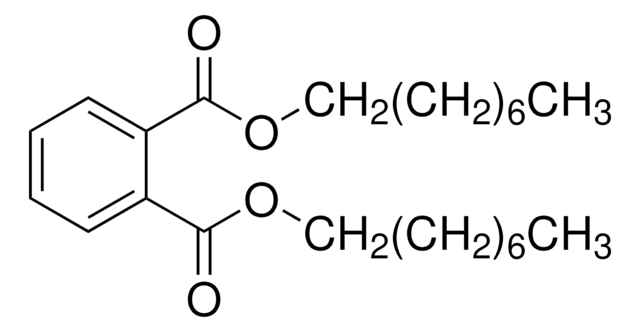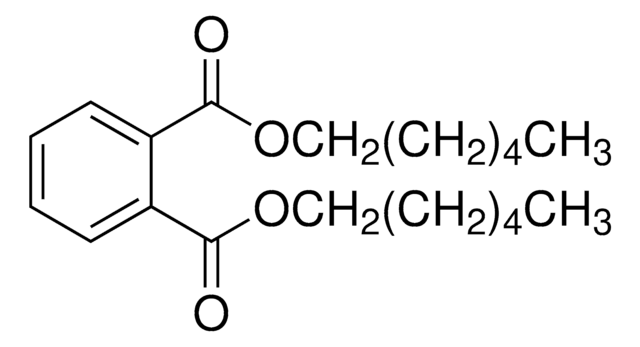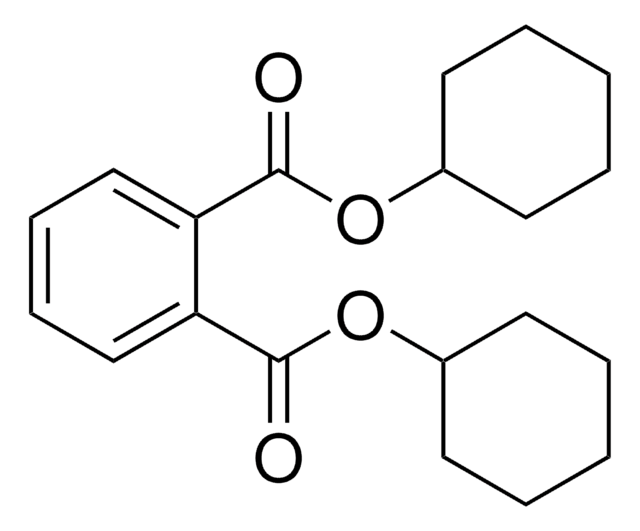Key Documents
80153
Di-n-octyl phthalate
≥98.0% (GC)
Synonim(y):
DNOP, Phthalic acid di-n-octyl ester
About This Item
Polecane produkty
Poziom jakości
Próba
≥98.0% (GC)
Postać
liquid
współczynnik refrakcji
n20/D 1.485
liczba kwasowa
≤3
gęstość
0.980 g/mL at 20 °C (lit.)
ciąg SMILES
CCCCCCCCOC(=O)c1ccccc1C(=O)OCCCCCCCC
InChI
1S/C24H38O4/c1-3-5-7-9-11-15-19-27-23(25)21-17-13-14-18-22(21)24(26)28-20-16-12-10-8-6-4-2/h13-14,17-18H,3-12,15-16,19-20H2,1-2H3
Klucz InChI
MQIUGAXCHLFZKX-UHFFFAOYSA-N
Szukasz podobnych produktów? Odwiedź Przewodnik dotyczący porównywania produktów
Opis ogólny
Zastosowanie
- Unified BARGE Method for Phthalate Migration: A simplified unified BARGE method has been proposed to assess the migration of phthalate esters from ingested PVC consumer products. This study focuses on the migration behaviors of phthalates like Di-n-octyl phthalate, aiding in regulatory assessments and consumer safety evaluations (Mohamed et al., 2023).
- ECTFE Porous Membrane for Dehumidification: The development of an ECTFE porous membrane for dehumidification of gaseous streams through a membrane condenser introduces a novel application of membrane technology, potentially incorporating Di-n-octyl phthalate as a process agent, enhancing industrial gas separation and purification processes (Pan et al., 2022).
Zwroty wskazujące rodzaj zagrożenia
Zwroty wskazujące środki ostrożności
Klasyfikacja zagrożeń
Aquatic Chronic 4
Kod klasy składowania
10 - Combustible liquids
Klasa zagrożenia wodnego (WGK)
WGK 1
Temperatura zapłonu (°F)
228.2 °F - closed cup
Temperatura zapłonu (°C)
109.0 °C - closed cup
Środki ochrony indywidualnej
Eyeshields, Gloves
Wybierz jedną z najnowszych wersji:
Masz już ten produkt?
Dokumenty związane z niedawno zakupionymi produktami zostały zamieszczone w Bibliotece dokumentów.
Klienci oglądali również te produkty
Nasz zespół naukowców ma doświadczenie we wszystkich obszarach badań, w tym w naukach przyrodniczych, materiałoznawstwie, syntezie chemicznej, chromatografii, analityce i wielu innych dziedzinach.
Skontaktuj się z zespołem ds. pomocy technicznej









